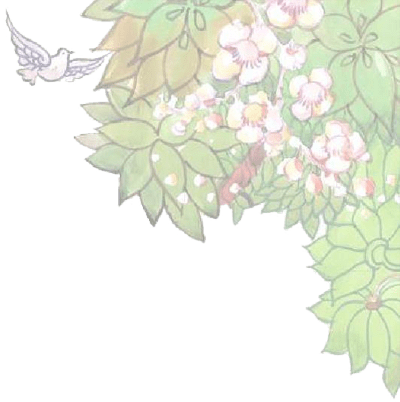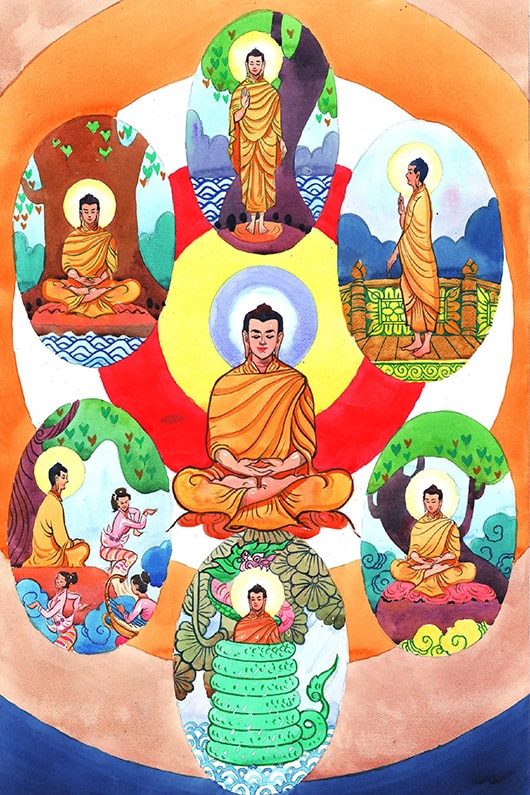21話 さとりの後の七週間

第2部 成道へ
第2章 さとり
21話 さとりの後の七週間
さとりの後、世尊は七週間、七つのさまざまな場所で過ごされた。菩提樹の下と、その周辺である。この期間は、どんな食ベ物も摂られなかった。世尊のからだはスジャーターが献上した乳粥の滋養物によって維持された。
菩提樹の下の最初の一週間・・・跏趺(パッランカ)の七日間(サッターハ)
世尊は菩提樹の下で足を組んで坐り、解脱の至福(ヴィムッティスカ)を味わいながら、その姿勢のまま、丸一週間とおして変えなかった。七日目に集中状態から出て、夜の初更に縁起(パティッチャサムッパーダ)の順観を観察した。
「これ有るとき、かれ有り。これ生ずれば、かれ生ず」
「無明(アヴィッジャー)に縁って行(サンカーラ)が生じる。
行(サンカーラ)に縁って識(ヴィンニャーナ)が生じる。
識(ヴィンニャーナ)に縁って名色(ナーマルーパ)が生じる。
名色(ナーマルーパ)に縁って六処(サラーヤタナ)が生じる。
六処(サラーヤタナ)に縁って触(パッサ)が生じる。
触(パッサ)に縁って受(ヴェーダナー)が生じる。
受(ヴェーダナー)に縁って渇愛(タンハー)が生じる。
渇愛(タンハー)に縁って固執(ウパーダーナ)が生じる。
固執(ウパーダーナ)に縁って有(バヴァ)が生じる。
有(バヴァ)に縁って生(ジャーティ)が生じる。
生(ジャーティ)に縁って老(ジャラー)、死(マラナン)が生じ、
愁(ソーカ)、悲(パリデーヴァ)、苦(ドゥッカ)、憂(ドーマナッサ)、悩(ウパーヤーサー)が現われる。
このようにして、このすべての苦蘊の生起がある」
世尊がこの教えをこのようにつぶさに考えていたとき、その意味をさらにはっきり理解した。その後に歓喜の偈頌を発した。
“Yadā have pātubhavanti dhammā,
Ātāpino jhāyato brāhmaṇassa;
Athassa kaṅkhā vapayanti sabbā,
Yato pajānāti sahetudhammam”
「熱心に冥想する聖者に、真理がすっかりあらわになる。
そのとき、かれの一切の疑惑は消え去る。
なぜなら、それぞれの現象には原因がある、と知っているのだから」
夜の第二更に、縁起の逆観を観察した。
「これ無いとき、かれ無し。これ滅すれば、かれ滅す」
これはすなわち「因縁の教え-滅観」で、以下の十二因縁である。
「無明(アヴィッジャー)こそが滅することに縁って行(サンカーラ)が滅する。
行(サンカーラ)が滅することに縁って識(ヴィンニャーナ)が滅する。
識(ヴィンニャーナ)が滅することに縁って名色(ナーマルーパ)が滅する。
名色(ナーマルーパ)が滅することに縁って六処(サラーヤタナ)が滅する。
六処(サラーヤタナ)が滅することに縁って触(パッサ)が滅する。
触(パッサ)が滅することに縁って受(ヴェーダナー)が滅する。
受(ヴェーダナー)が滅することに縁って渇愛(タンハー)が滅する。
渇愛(タンハー)が滅することに縁って固執(ウパーダーナ)が滅する。
固執(ウパーダーナ)が滅することに縁って有(バヴァ)が滅する。
有(バヴァ)が滅することに縁って生(ジャーティ)が滅する。
生(ジャーティ)が滅することに縁って老(ジャラー)、死(マラナン)が滅し、
愁(ソーカ)、悲(パリデーヴァ)、苦(ドゥッカ)、憂(ドーマナッサ)、悩(ウパーヤーサー)が滅する。
このようにして、このすべての苦蘊の滅がある」
さらに世尊がこの逆観の教えをつぶさに考えていたとき、その意味をさらにはっきり理解した。その後に歓喜の偈頌を発した。
“Yadā have pātubhavanti dhammā,
Ātāpino jhāyato brāhmaṇassa;
Athassa kaṅkhā vapayanti sabbā,
Yato khayaṃ paccayānaṃ avedi”.
「熱心に冥想する聖者に、真理がすっかりあらわになる。
そのとき、かれの一切の疑惑は消え去る。
なぜなら、もろもろの原因は滅する、と知覚したのだから」
夜の第三更に、縁起の順観と逆観を観察した。
「これ有るとき、かれ有り。これ生ずれば、かれ生ず
これ無いとき、かれ無し。これ滅すれば、かれ滅す」
これはすなわち「因縁の教え-順観と滅観」で、以下の十二因縁である。
「無明に縁って行が生じる。
行に縁って識が生じる。
(中略)
生に縁って老、死が生じ、
愁、悲、苦、憂、悩が現われる。
このようにして、このすべての苦蘊の生起がある。
無明こそが滅することに縁って行が滅する。
行が滅することに縁って識が滅する。
(中略)
識が滅することに縁って名色が滅する。
生が滅することに縁って老、死が滅し、
愁、悲、苦、憂、悩が滅する。
このようにして、このすべての苦蘊の滅がある」
世尊がこの教えを順観と逆観でつぶさに考えていたとき、その意味をさらにさらに、はっきり明瞭に理解した。その後に歓喜の偈頌を発した。
“Yadā have pātubhavanti dhammā,
Ātāpino jhāyato brāhmaṇassa;
Vidhūpayaṃ tiṭṭhati mārasenaṃ,
Sūriyova obhāsayamantalikkhaṃ”
「熱心に冥想する聖者に、真理がすっかりあらわになる。
そのとき、かれは悪魔の軍勢を蹴散らして敗走させる。
あたかも太陽が天空を輝かせるがごとく」
この最初の一週間は跏趺(パッランカ)(結跏趺坐、坐る冥想)の七日間として知られている。なぜなら世尊は菩提樹の下の無敵の玉座(金剛宝座)の上に七日間坐り続けたからである。
菩提樹を見つめる二週間目・・・無瞬目(アニミサ)の七日間(サッターハ)
八日目に世尊は、無敵の玉座で坐っている姿勢から立ち上がり、北東方向に若干の距離を踏み出した。それから一本の黄金柱のようにしっかり立ち、眼を閉じないまま一週間ずっと菩提樹を見つめ続けた。
世尊は、動かないものである菩提樹にさえ、さとりへ向けてみずから格闘しているあいだに木陰でおおってくれたことへ深い満足を示すことによって、わたしたちに偉大な功徳の行為を教えられているのである。この一週間は無瞬目(アニミサ)(まばたきなし)の七日間として知られている。そして世尊が立っていた場所はアニミサ・チェーティア(廟)と呼ばれている。
この世尊の高貴な態度は全仏教徒が継承して、オリジナルの菩提樹だけでなく、その子孫の菩提樹にも敬意を払うべきだ。世尊がこのように動かないものにさえ深い満足を払われたように、わたしたちはさらにもっと、ほかの生きとし生けるものにも真摯な満足を示すべきなのだ。
宝石の経行処の三週間目・・・経行(チャンカマ)の七日間
二週間が過ぎた。しかし世尊は菩提樹の周辺に滞在したままであった。神々のうちのある者は世尊がなぜ、まだそこにいるのか、ふしぎがった。かれらは世尊のさとりを疑った。二週間目の立つ冥想から出られて、世尊の心の眼でかれらの考えを知られた。かれらの疑いを取り除くために、世尊は空中に宝石の経行処(ラタナチャンカマ)を創りだされ、行きつ戻りつ、歩く冥想をされた。それと同時に世尊は真理(ダンマ)についてつぶさに考えられ、阿羅漢果の達成の中に没入していかれた。このように世尊は、三週間目のすべてを過ごされた。それは経行(チャンカマ)(訳注:冥想しつつ反復歩行すること。禅宗では“きんひん”と訓む)の七日間(サッターハ)として知られている。
宝石の家の四週間目・・・宝石の家(ラタナガラ)の七日間(サッターハ)
神々(デーヴァー)の疑いを取り除いて、四週間目の世尊は、神々(デーヴァー)によって菩提樹の北西の場所に創られた宝石の家(ラタナガラ)の内側で七日間、足を組んで坐った。
その場で世尊は、ブッダの“高度な”または“特別な”教えを納めた籠という意味の論蔵(アビダンマ ピタカ)を熟考した。その集成は七つの論書、すなわち「法集論(ダンマサンガニー)」「分別論(ヴィバンガ)」「界論(ダートゥカター)」「人施設論(プッガラパンニャッティ)」「論事(カターヴァットゥ)」「双論(ヤマカ)」「発趣論(パッターナ)」である。七つのうちのはじめの六つの論を調べているときは、世尊のからだは光線を出さなかった。しかしながら「発趣論」に至って世尊の全智は壮大な輝きを見せる機会を確実に得ている。ちょうど巨大魚である呑舟の大魚(ティミラピンガラ)(訳注:舟をまる呑みするほどの大きな魚)は深さ八万四千ヨージャナ(百万㌔超)の広大な大海原の中でしか泳いで遊ぶ機会を得られないように、世尊の全智は大論書の中にのみ真実のふさわしい空間をみつけているのだ。
このように世尊は大論書「発趣論(パッターナ)」についてつぶさに微妙かつ甚深の真理を無限数の方法で考察され、世尊の心身はあまりに清浄となり、青(ニーラ)、金(ピータ)、赤(ローヒタ)、白(オーダータ)、橙(マンジッタ)、そしてこの五色混合によるまばゆい極光浄(パッバッサラ)という六色の光線(チャッバンナランシ)が世尊のからだから放射されたのである。六色それぞれの色はブッダの気高く貴い性質を象徴している。青は信を、金は聖を、赤は智を、白は純粋を、橙は無貪を、そして極光浄はこうした気高く貴い性質の結合を、それぞれ象徴している。
この四週間目の論蔵(アビダンマ ピタカ)についての想起、沈潜は、宝石の家(ラタナガラ)の七日間(サッターハ)として知られている。
山羊飼いのバニヤン樹のもとの五週間目・・・アジャパーラの七日間
菩提樹近辺で四週間過ごしたあと、世尊は菩提樹の東側にある山羊飼いのバニヤン樹(アジャパーラ榕樹)の根もとへ行かれた。その樹下で足を組んで坐り、解脱の至福にひたりながら七日間過ごされた。
そのころ高慢な性格のバラモンが世尊に近づいてきた。礼儀正しく親しみのあるあいさつを交わしたあと、かれは一隅に立ち、世尊に尋ねた。
「おお、尊い方ゴータマよ、いったいどんな美徳によって人はバラモンになるのでしょうか? そして、どのような条件が人をバラモンたらしめるのでしょうか?」
このバラモンの質問の意義を明確に理解されて、世尊は歓喜の偈頌を発された。
「悪徳を取り除き、
傲慢から自由になり、汚れなく、自制する。
智慧の極致となり、清浄行の実践を完成する。
その人こそ、この世のどこにおいても
真の『聖者』と呼ばれる」
この週のあいだも、悪魔の三人娘である渇愛(タンハー)、嫌悪(アラティ)、貪欲(ラーガ)は世尊を誘惑しにやってきていた。肉体の美しさを見せつけたり、誘惑する言葉をかけたり、気をひくような魅力的な踊りをしてみせたり、そのほか心を惑わせるしぐさをしてみせたりした。こうしたあらゆる誘惑に注意する代わりに、世尊は眼を閉じて冥想を続けたのである。
このように世尊は、アジャパーラの七日間(サッターハ)として知られる五週間目をアジャパーラ・バニヤン樹の下で過ごした。
ムチャリンダ樹のもとの六週間目・・・ムチャリンダの七日間(サッターハ)
七日目の終わりに、世尊は坐る冥想の集中から立ち上がり、アジャパーラ・バニヤン樹の近くのムチャリンダ樹(原注:ラテン語:Barringtonia(バーリングトニア) acutangula(アクタングラ))の根もとへ行った。ムチャリンダ樹の下で世尊は足を組んで坐り、解脱の至福にひたりながら七日間過ごされた。
この間、季節はずれの大嵐が発生した。嵐は大雨、冷風、暗天をともなって七日間続いた。大雨到来を知って豪腕の龍王ムチャリンダが龍宮からやってきた。大蛇のコブラのような龍王は世尊のからだを七重巻きにして頭についている大きな幌(鎌首)で世尊の頭を保護した。「世尊が、寒さや暑さ、虻や蚊、風、日差し、地面を這うものに害されないように」と考えながら、そうしたのである。
七日間の終わりに空が晴れ、雲が消えた。もはや世尊を保護する必要がなくなったのでムチャリンダはグルグルとぐろを巻いて保護していたのをほどいた。みずからの姿かたちを消して、若いバラモンの身装りになって世尊の前に立ち、尊崇の思いから両手を合わせた。
その後すぐに、世尊は二つの厳粛な法悦の偈を発した。
「足るを知る(知足)者にとって、遠離は楽しい。
真理を聞いて見ている者にとって、
この世で慈悲は楽しい。
生きとし生けるものに害意を自制するのも楽しい」
「この世で感情から離れるのは楽しい。
もろもろの感覚の快楽を乗り超える者にとって、
『我がいる』という慢心をなくすことは、
じつに何よりも最上の楽しみである」
このように六週間目は、世尊が龍(ナーガ)王ムチャリンダに七重巻きになってその中で過ごされたときで、ムチャリンダの七日間(サッターハ)として知られている。
ラージャーヤタナ樹のもとの七週間目・・・ラージャーヤタナの七日間(サッターハ)
この週のあいだ、世尊は冥想の集中から出られてムチャリンダ樹のもとから菩提樹の南側のラージャーヤタナ樹(原注:ラテン語:Buchanania(ブカナニア) latifolia(ラティフォリア))のもとへ行かれた。世尊は樹下で足を組んで坐り、何のわずらいもなく、解脱の至福にひたりながら日々を過ごされた。かくて、世尊はラージャーヤタナの七日間として知られる七週間目をラージャーヤタナ樹の下で過ごされたのである。
※ 画像やテキストの無断使用はご遠慮ください。/ All rights reserved.

Episode 21
SEVEN WEEKS AFTER ENLIGHTENMENT
After His Enlightenment, the Blessed One stayed for seven weeks in seven different places—under the Bodhi tree and its neighbourhood. During that period, He did not take any food; His body was sustained by the nutrients of the milk-rice given by Sujātā.
The First Week Under the Bodhi Tree
The Blessed One sat cross-legged under the Bodhi tree without changing His position throughout the whole first week, experiencing the bliss of Emancipation (vimuttisukha). On the seventh day, He emerged from that state of concentration, and during the first watch of the night He contemplated the Dependent Origination
(Paṭiccasamuppāda) in this forward order: “When this exists, that comes to be; with the arising of this, that arises; that is to say:
Dependent on ignorance (avijjā), arise kammic (mental) formations (saṅkhārā).
Dependent on kammic formations, arises consciousness (viññāṇa).
Dependent on consciousness, arise mind and matter (nāmarūpa).
Dependent on mind and matter, arise the six sense bases (saḷāyatana).
Dependent on six sense bases, arises contact (phassa).
Dependent on contact, arises feeling (vedanā).
Dependent on feeling, arises craving (taṇhā).
Dependent on craving, arises clinging (upādāna).
Dependent on clinging, arises existence (bhava).
Dependent on existence, arises birth (jāti).
Dependent on birth, arise decay and death (jarāmaraṇa), sorrow (soka),
lamentation (parideva), pain (dukkha), grief (domanassa), and despair
(upāyāsa).
Thus arises this whole mass of suffering.”
When the Blessed One reflected on this doctrine thus, He understood
its meaning more clearly; thereupon He uttered a paean of joy:
“Yadā have pātubhavanti dhammā
Ātāpino jhāyato brāhmaṇassa
Athassa kaṅkhā vapayanti sabbā
Yato pajānāti sahetudhammaṁ”
“When the Truths are fully manifest
To the ardent meditating brahmin,
His doubts then all vanish,
For he knows that each thing must have its cause.”
In the second watch of the night, He contemplated the Dependent Origination in this reverse order: “When this does not exist, that does not come to be; with the cessation of this, that ceases; that is to say:
“With the cessation of ignorance, kammic (mental) formations cease.
With the cessation of kammic formations, consciousness ceases.
With the cessation of consciousness, mind and matter cease.
With the cessation of mind and matter, the six sense bases cease.
With the cessation of six sense bases, contact ceases.
With the cessation of contact, feeling ceases.
With the cessation of feeling, craving ceases.
With the cessation of craving, clinging ceases.
With the cessation of clinging, existence ceases.
With the cessation of existence, birth ceases.
With the cessation of birth, decay and death, sorrow, lamentation, pain, grief, and despair cease. Thus ceases this whole mass of suffering.”
As well, when the Blessed One reflected on this doctrine in the reverse order, He understood its meaning more clearly; thereupon He uttered a paean of joy:
“Yadā have pātubhavanti dhammā
Ātāpino jhāyato brāhmaṇassa
Athassa kaṅkhā vapayanti sabbā
Yato khayaṁ paccayānaṁ avedi”
“When the Truths are fully manifest To the ardent meditating brahmin,
His doubts then all vanish, For he perceives the destruction of the causes.”
In the third watch of the night, He contemplated the Dependent Origination in the forward and reverse order: “When this exists, that comes to be; with the arising of this, that arises. When this does not exist, that does not come to be; with the cessation of this, that ceases, that is to say:
“Dependent on ignorance, arise kammic (mental) formations.
Dependent on kammic formations, arises consciousness…and so forth.
Dependent on birth, arise decay and death, sorrow, lamentation, pain,
grief, and despair. Thus arises this whole mass of suffering.”
“With the cessation of ignorance, kammic (mental) formations cease.
With the cessation of kammic formations, consciousness ceases…and so forth.
With the cessation of birth, decay and death, sorrow, lamentation, pain, grief, and despair cease. Thus ceases this whole mass of suffering.”
When the Blessed One reflected on this doctrine in the forward and reverse order, He understood its meaning more and more, clearer and clearer; thereupon He uttered a paean of joy:
“Yadā have pātubhavanti dhammā
Ātāpino jhāyato brāhmaṇassa
Vidhūpayaṁ tiṭṭhati mārasenaṁ
Sūriyo va obhāsayamantalikkhaṁ”
“When the Truths are fully manifest To the ardent meditating brahmin,
Then he stands routing the hosts of the Evil One Just as the sun illuminates the sky.”
This first week is known as pallaṅka sattāha because the Blessed One continued sitting on the Invincible Throne under the Bodhi tree for seven days.
The Second Week of Gazing the Bodhi Tree
On the eighth day, the Blessed One rose from His sitting position on the Invincible Throne and stepped towards the northeast direction for a certain distance. Then, He stood firmly like a golden post gazing at the Bodhi tree constantly without closing His eyes for a whole week.
The Blessed One taught us a great moral deed by showing His deep gratitude, even to an inanimate thing, the Bodhi tree, which had sheltered Him during His struggle for Enlightenment. This week is known as animisa sattāha, and the spot where the Blessed One stood is called Animisa Cetiya.
This noble attitude of the Blessed One should be followed by all Buddhists by paying respect not only to the original Bodhi tree, but also its descendants. As the Blessed One paid such a deep gratitude even to inanimate things, we should all the more show our sincere gratitude to other living beings.
The Third Week on the Jewelled Walk
Two weeks had passed, but the Blessed One kept staying in the neighbourhood of the Bodhi tree. Some devas wondered why the Blessed One was still there; they doubted His Enlightenment. Having emerged from His standing meditation in the second week, through His mind’s eye the Blessed One came to know their thoughts. To remove their doubts, He created a jewelled walk (ratanacaṅkama) in the air and paced up and down; at the same time He was reflecting on the Dhamma and getting absorbed in the Fruition attainment. Thus, the Blessed One spent for the whole third week—known as caṅkama sattāha.
The Fourth Week in the Jewel House
Having removed the doubts of the devas, in the fourth week the Blessed One sat cross-legged for seven days inside a jewel house (ratanaghara)—created by devas on the spot to the northwest of the Bodhi tree.
There, He contemplated the Abhidhamma Piṭaka, the basket of the Buddha’s “higher” or “special” doctrine. The collection consists of seven treatises, viz. the Dhammasaṅgaṇī, the Vibhaṅga, the Dhātukathā, the Puggalapaññatti, the Kathāvatthu, the Yamaka, and the Paṭṭhāna. When He was investigating the first six treatises, His body did not emit rays. However, upon coming to the Paṭṭhāna, His omniscience certainly found its opportunity to display its magnificent brilliance.
For just as the great fish timiratipiṅgala gets a chance to swim and play only in the great ocean eighty-four thousand yojanas in depth, so it is that His omniscience truly finds room only in the Great Treatise.
Thus, as the Blessed One was reflecting on the subtle and profound Dhamma of the Great Treatise Paṭṭhāna with an unlimited number of methods, His mind and body became so pure that rays of six colours (chabbaṇṇaraṁsi)—blue (nīla), golden (pīta), red (lohita), white (odāta), orange (mañjiṭṭha), and a dazzling colour formed as a mixture of these five colours (pabhassara)—emitted from His body. Each of these colours represents the noble qualities of the Buddha. Blue represents confidence, golden for holiness, red for wisdom, white for purity, orange for desirelessness, while the dazzling colour represents a combination of all these noble qualities.
This fourth week of recollecting on Abhidhamma Piṭaka is known as ratanaghara sattāha.
The Fifth Week at the Goatherds’ Banyan Tree
Having passed four weeks in the vicinity of the Bodhi tree, the Blessed One proceeded to the foot of the goatherds’ banyan tree situated to the east of the Bodhi tree. He sat cross-legged under it and spent seven days enjoying the bliss of Emancipation.
At that time, a brahmin of haughty nature (huhuṅkajātika) approached the Blessed One. After exchanging courteous and pleasant greetings, he stood on one side and asked the Blessed One: “By what virtues does one become a brāhmaṇa, O Venerable Gotama? And what are the conditions that make one a brāhmaṇa?”
Clearly understanding the meaning of the brahmin’s question, the Blessed One exclaimed a paean of joy:
“One who has rid himself of evil things,
Free from haughtiness, undefiled and self-controlled,
Perfect in knowledge, and has completed the Holy Life,
Would one rightly call him a ‘brāhmaṇa’.
For him there is no elation anywhere in this world.”
During this week, too, the three daughters of Māra—Taṇhā, Arati and Rāga—came enticing the Blessed One by showing their bodily beauty, by uttering seductive words, by dancing in the most charming and alluring ways, and by performing other illusory performances. Instead of paying attention to all these temptations, the Blessed One closed His eyes and continued His meditation.
Thus, the Blessed One passed the fifth week—known as ajapāla sattāha—under the ajapāla banyan tree.
The Sixth Week at the Foot of the Mucalinda Tree
At the end of the seventh day, the Blessed One rose from His concentration and went to the foot of the mucalinda tree (Latin: Barringtonia acutangula) near the ajapāla banyan tree. Under this mucalinda tree, the Blessed One spent seven days sitting cross-legged, enjoying the bliss of Emancipation.
During this time, great storms arose out of season; the storms continued for seven days with a great rain, cold winds and a gloomy weather. Knowing that there was a great rain, Mucalinda, the powerful nāga king, came out from his abode. He encircled the Blessed One’s body seven times with his coils and covered the Blessed One’s head with his great hood, thinking: “Let the Blessed One be not afflicted by cold or heat or touched by gadflies, mosquitoes, wind, the sun and creeping things.”
At the end of the seven days, the sky became clear and cloudless. As it was no longer necessary to cover the Blessed One, Mucalinda unwrapped his coils from the Blessed One’s body. He made his own form vanish and assumed the guise of a brahmin youth standing in front of the Blessed One with hands clasped in veneration.
Thereupon, the Blessed One uttered two solemn verses of ecstasy:
“Seclusion is happiness for one who is contented
To whom the Truth is heard, and who has seen.
Friendliness in this world is happiness,
So is restraint towards living beings.”
“Detachment from passion in this world is happiness
For him that has surmounted sensual pleasures
Having completely eliminated the conceit ‘I am’
That is indeed the greatest happiness of all.”
Thus the sixth week, the time when the Blessed One stayed inside the
seven coils of Mucalinda the nāga king, is known as mucalinda sattāha.
The Seventh Week Under the Rājāyatana Tree
During this week, the Blessed One emerged from His concentration and went from the foot of the mucalinda tree to the rājāyatana tree (Latin: Buchanania latifolia) situated to the south of the Bodhi tree. He sat cross-legged under the tree passing the days without any disturbances, experiencing the bliss of Emancipation. Thus, the Blessed One spent the seventh week—known as rājāyatana sattāha—at the
foot of the rājāyatana tree.
※ 画像やテキストの無断使用はご遠慮ください。/ All rights reserved.
アシン・クサラダンマ長老
1966年11月21日、インドネシア中部のジャワ州テマングン生まれ。中国系インドネシア人。テマングンは近くに3000メートル級の山々が聳え、山々に囲まれた小さな町。世界遺産のボロブドゥール寺院やディエン高原など観光地にも2,3時間で行ける比較的涼しい土地という。インドネシア・バンドゥンのパラヤンガン大学経済学部(経営学専攻)卒業後、首都ジャカルタのプラセトエイヤ・モレヤ経済ビジネス・スクールで財政学を修め、修士号を取得して卒業後、2年弱、民間企業勤務。1998年インドネシア・テーラワーダ(上座)仏教サンガで沙弥出家し、見習い僧に。詳しく見る
奥田 昭則
1949年徳島県生まれ。日本テーラワーダ仏教協会会員。東京大学仏文科卒。毎日新聞記者として奈良、広島、神戸の各支局、大阪本社の社会部、学芸部、神戸支局編集委員などを経て大阪本社編集局編集委員。1982年の1年間米国の地方紙で研修遊学。2017年ミャンマーに渡り、比丘出家。詳しく見る

※ 画像やテキストの無断使用はご遠慮ください。
All rights reserved.

